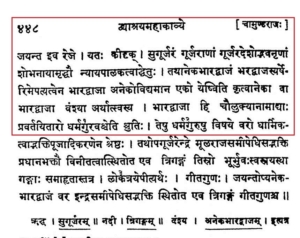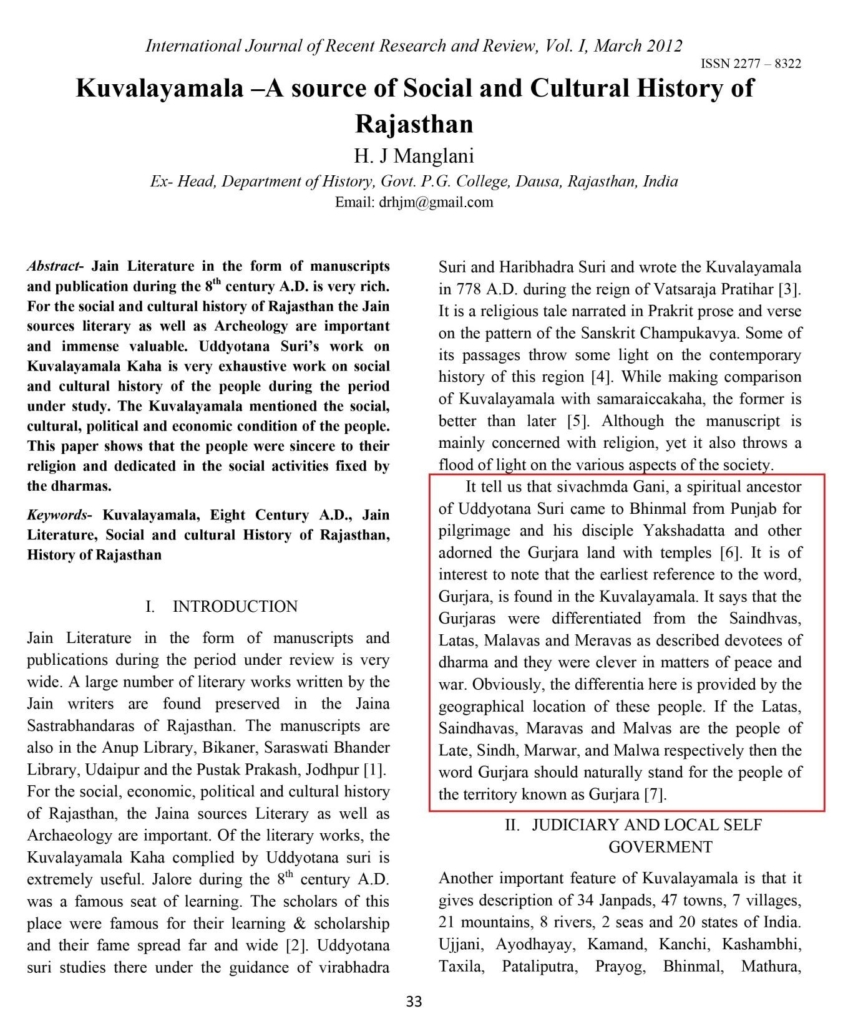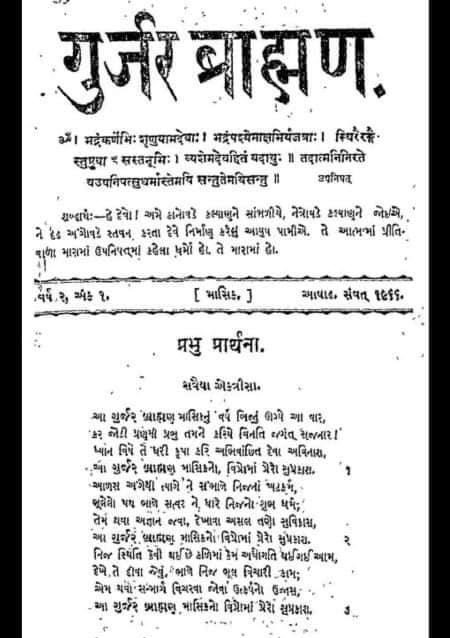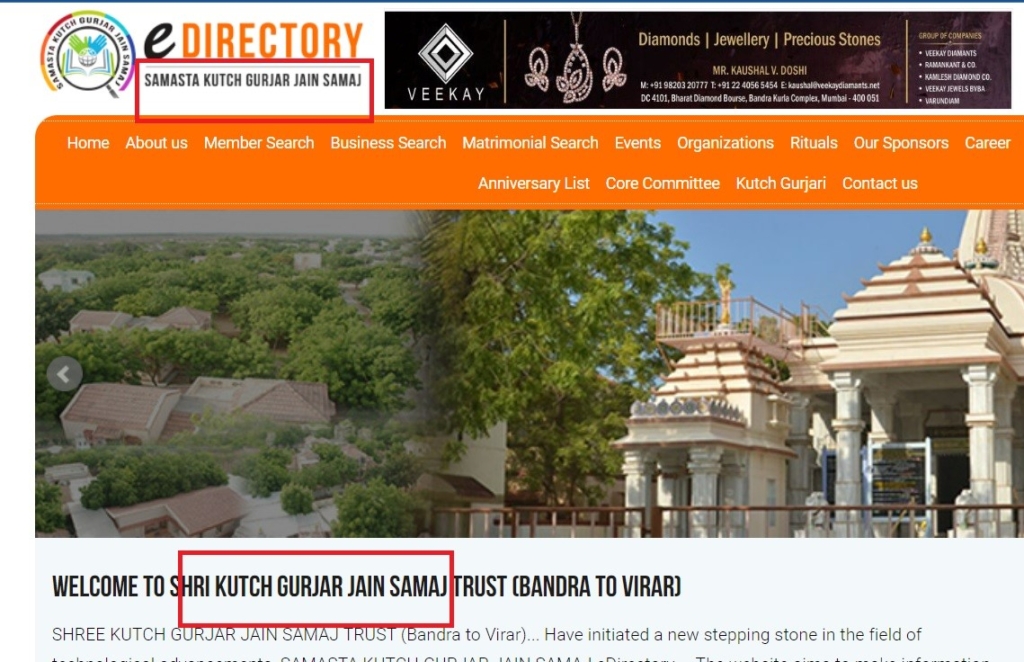Gurjara – The Regional Identity of the people of Gurjaradesa
-
- Meaning of word गुर्जर: (Gurjara) : in the well-known and critically acclaimed work of VS Apte “The practical Sanskrit-English dictionary”, are:
- The district (area) of Gujarat.
- An inhabitant of Gujarat; तेषां मार्गे परिचयवशादर्जितं गुर्जराणां यः संतापं शिथिलमकरोत् सोमनाथं विलोक्य 18.97.Gurjara – A Regional IdentityWe begin with the famous Panchatantra which has arguably the first ever record of the term Gurjara. The date of Panchatantra’s creation is given quite variably from 300 BCE to the Gupta era i.e. before 400 AD.The text has two instances of the word – Gurjaradeśe gantavyaṃ and Gurjaradeśaṃ gatvā [Book 4, Ch 10, Pg 443-44]. Both instances appear in the same story where a poor charioteer goes to Gurjaradesha (Gurjara country) to buy a camel. As is evident this earliest occurrence bears a geographic connotation and not an ethnic one. The Map of Gurjara Region in 641 AD, we can see Jabalipura (Jalore), Bhillamal (bhinmal) and Mandavyapura (Mandore) being part of the Gurjara region in 641 AD
- Source: The Practical Sanskrit-English Dictionary by VS Apte, Page 464

- Dvyashraya Mahavkya (13th Century) with commentary by Abhayatilaka Gani
The 13th-century scholar Abhayatilaka Gani in his commentary of Hemachandra’s DvyashrayaMahakavya chapter 6, interprets “Gurjaranāṃ” (the plural i.e. Gurjars) as ‘Gurjara-deśodbhava-nraṇām’. Meaning – the people born in the desha called Gurajara.
- Source: Dvyashraya Mahavkya Chapter 6, verse 7 Pg 447-448https://archive.org/details/in.ernet.dli.2015.322213/page/n491/mode/1up
 The conclusion is inescapable that this Gujjar tribe makes its appearance at a much later date.
The conclusion is inescapable that this Gujjar tribe makes its appearance at a much later date.  Source: International Journal of Recent Research and Review, Vol. I, March 2012: Kuvalyamala – A source of socio-cultural history of Rajasthan by HJ Manglanihttp://www.ijrrr.com/papers/7%20Samaraiccakaha.pdf
Source: International Journal of Recent Research and Review, Vol. I, March 2012: Kuvalyamala – A source of socio-cultural history of Rajasthan by HJ Manglanihttp://www.ijrrr.com/papers/7%20Samaraiccakaha.pdf
- 4. Sravana Belagola Epigraph (974 AD) says –
Ganga Dynasty (Karnataka) King Satyavakya Kongunivarman became ‘Gurjara Adhiraja’ (गुर्जर अधिराज) by conquering northern areas for Rastrakuta King Krishna III around 974 AD. Gurjara denoted geographic area consisting of parts of Rajasthan & Gujarat. Point to be noted is that neither Rashtrakuts nor Gangaya kings can be Gujjars. This is a conclusive evidence that Gurjara word in epigraphs were used to denote a region.

Source: Sravana-Belagola Inscription, Epigraphica Indica Vol 5, Pg 176
https://archive.org/details/in.ernet.dli.2015.71071/page/n226/mode/1up
- 5. Tasgaon Plates of Yadava Krishna (1251 AD)
Tasgaon plates of Yadava Krishna mentions a Gurjara Brahmin named Shatananda of Krishna-atreya Kula. Again the term “Gurjara” doesn’t signify any caste here, but is a geographical connotation for a Brahmin from Gurjaradesa.

Source: Tasgaon Plates of Yadav King King Krishna (1048 AD), Epigraphia Indica Vol 27 Pg 209 https://archive.org/details/in.ernet.dli.2015.56527/page/n290/mode/1up
- 6. Prabhavaka Charita (13th century AD) is a Jain text composed by Jain scholar Prabhachandra Acharya which clearly says that the word “Gurjara” represents a region: अस्ति स्वस्तिनिधिः श्रीमान् देशो गुर्जरसंज्ञया।
“The country (देशः) by the name Gurjara (गुर्जर), which is the abode (निधिः) of wealth and auspiciousness.”
 Source: Prabhavak Charit by Prabhachandra Acharya Pg 124 Verse 4 https://archive.org/details/in.ernet.dli.2015.311048/page/n133/mode/1up?view=theater
Source: Prabhavak Charit by Prabhachandra Acharya Pg 124 Verse 4 https://archive.org/details/in.ernet.dli.2015.311048/page/n133/mode/1up?view=theaterEnglish Translation of the Verse

Source: Rajsthan through the Ages Vol 1 by Dashrath Sharma Page 114
- 7. The Collected Works of Mahatma Gandhi, Vol. 14
Talks about a garden party in honour of Mahatma Gandhi organised by Gurjara Sabha in 1915.
This Gurjara Sabha (1915) was attended by Mahatma Gandhi, KM Munshi (a Gurjar Vyas Brahmin himself) and presided by Mohd. Ali Jinnah, none of the attendees belonged to the Gujar community, but was all about Gujaratis.

Source:The Collected Works of Mahatma Gandhi, Vol. 14 Pg 342
https://www.gandhiashramsevagram.org/gandhi-literature/mahatma-gandhi-collected-works-volume-14.pdf
- 8. King of princely state of Baroda “Pratap Rao Gaekwad” a Maratha by Caste, was also called Gurjar Naresh, because he ruled that territory of erstwhile Gurjara Desha and not because he belonged to Gurjar Caste.

Source: http://www.poloclubofbaroda.org/history.php
- 9. Gurjar Brahman Vars by Harjivan Tripathi, published in 1909

Source : Gurjar Brahaman Vars -1 Vol -1 by Harjivan Tripati https://archive.org/details/in.ernet.dli.2015.543312/page/n1/mode/2up
- 10. Gujar Pasi
According to CENSUS OF INDIA 1971 SERIES I-INDIA MONOGRAPH SERIES PART V, Gujar Pasis (Schedule Caste) of Awadh region in Uttar Pradesh are said to be migrants of Gujarat and have been decisively documented as unrelated to Gujjar community in the Census report. Again, Gujar/Gurjar was decisively used as a regional identity for people of Gujarat.

- Source : Census Of India 1971 Series I-India Monograph Series Part V, Ministry of Home Affairs, Pg 7
- 10. Gurjar Jains


Source: https://skgjsedirectory.org/
Thus, Gurjara has always been a regional identity, rather than a caste.

